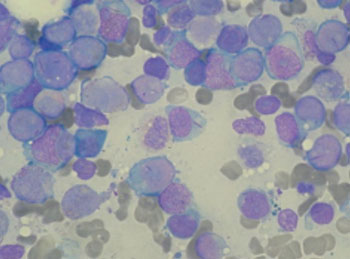MicroRNA Downregulation Boosts Growth of Acute Myeloid Leukemia Cells
By LabMedica International staff writers
Posted on 10 May 2016
Acute myeloid leukemia (AML) cells have developed a mechanism to suppress the activity of the microRNA miR-22, which would otherwise act to block their growth.Posted on 10 May 2016
AML is a cancer of the myeloid line of blood cells, characterized by the rapid growth of abnormal white blood cells that accumulate in the bone marrow and interfere with the production of normal blood cells. The symptoms of AML are caused by replacement of normal bone marrow with leukemic cells, which causes a drop in red blood cells, platelets, and normal white blood cells. Symptoms include fatigue, shortness of breath, easy bruising and bleeding, and increased risk of infection. AML progresses rapidly and is typically fatal within weeks or months if left untreated.

Image: A photomicrograph of myeloblasts in bone marrow of patient with acute myeloid leukemia (AML) (Photo courtesy of Wikimedia Commons).
Investigators at the University of Cincinnati (OH, USA) worked mainly with AML cells growing in culture. They reported in the April 26, 2016, online edition of the journal Nature Communications that the microRNA miR-22 was an essential tumor suppressor and that it was significantly downregulated in AML. Forced expression of miR-22 significantly suppressed leukemic cell viability and growth in vitro and substantially inhibited leukemia development and maintenance in vivo.
The investigators found that at the molecular level miR-22 targeted multiple oncogenes, including CRTC1 (CREB-regulated transcription coactivator 1), FLT3 (Fms-like tyrosine kinase 3) and MYCBP (C-Myc-binding protein), and thus repressed the CREB and MYC pathways. The downregulation of miR-22 in AML was caused by the activity of the TET1/GFI1/EZH2/SIN3A signaling pathway and/or by DNA copy-number loss. Furthermore, nanoparticles carrying miR-22 oligonucleotides significantly inhibited leukemia progression in vivo.
"MicroRNAs make up a class of small, non-coding internal RNAs that control a gene’s job, or expression, by directing their target messaging RNAs, or mRNAs, to inhibit or stop. Cellular organisms use mRNA to convey genetic information,” said senior author Dr. Jianjun Chen, associate professor of cancer biology at the University of Cincinnati. "When we forced miR-22 expression, we saw difficulty in leukemia cells developing, growing and thriving. miR-22 targets multiple cancer causing genes (CRTC1, FLT3 and MYCBP) and blocks certain pathways (CREB and MYC). The down-regulation, or decreased output, of miR-22 in AML is caused by the loss of the number of DNA being copied and/or stopping their expression through a pathway called TET1/GFI1/EZH2/SIN3A. Also, nanoparticles carrying miR-22 DNA oligonucleotides (short nucleic acid molecules) prevented leukemia advancement. More research on this pathway and ways to target it are necessary.”
Related Links:
University of Cincinnati













